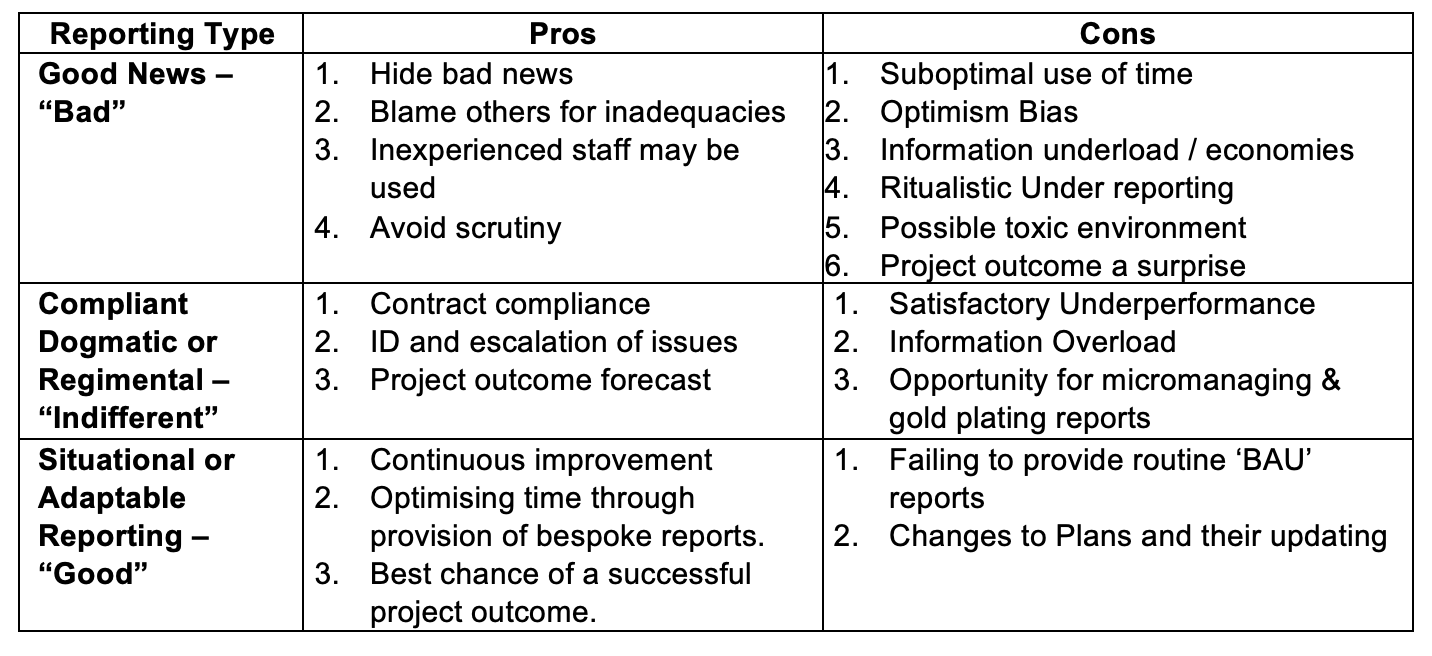 This is a story about project reporting, and its importance to project management. No matter how many or how few reports there are, it’s the report that provides the information that managers need to make decisions. It’s also not about the glut or the dearth though, it’s about the quality of the content and timing of delivery that can make all the difference between right or wrong decisions, and a project’s overall outcome.
This is a story about project reporting, and its importance to project management. No matter how many or how few reports there are, it’s the report that provides the information that managers need to make decisions. It’s also not about the glut or the dearth though, it’s about the quality of the content and timing of delivery that can make all the difference between right or wrong decisions, and a project’s overall outcome.
So, if you are sitting comfortably then I’ll begin.
The Project
Once upon a time in a faraway land there was a lumpsum construction project that the country needed to expand its infrastructure. The Client wanted the project to be built to his requirements and engaged the Contractor to do the work of designing and building the scheme as per the Client’s Contract conditions.
The Client also wanted the project to be built on time and with no surprises, especially any increased costs. To make sure the Contractor lived up to these expectations the Client also engaged the Consultant to supervise and ‘manage’ the Client’s ‘best’ interests.
The Plans
The Contract required a comprehensive suite of management plans from the Contractor. The Client mandated that if these weren’t delivered on time, and approved by the Consultant, then the Contractor wouldn’t be paid and would be penalised for not delivering them. The Consultant had to approve the plans but didn’t like the idea of changing them too much as this could implicate them if anything were to go wrong. The Plans were approved and showed that everybody had done a good job and any anger from the Client, or lack of payment was avoided.
An unhappy Client was the farthest thing from the Consultant mind, he wanted to keep the Client happy at all costs as well as avoid any adverse criticism. He thought that this was his primary role which could be achieved by ensuring that the Contractor would be blamed for any project shortcomings. So, once the Consultant had approved the Contractor’s plans. the plans became sacrosanct and, like tablets of stone, lithified.
The Reports
The Management Plans included for extensive reporting requirements because the Contract demanded prescribed reports covering all aspects of the work. Reports were required at daily, weekly, monthly, and quarterly intervals including one each quadrimester. There was no shortage of reports albeit the same information was merely being presented in a variety of different ways through written reports, proforma tables, PowerPoint presentations and face-to-face as well as virtual meetings – there no shortage of mandated communication!
Project reporting must be consistent, after all there should only be one version of the ‘truth’. For consistency the Consultant copied the detail of the Contractor’s reports to the Client adding their own spin on things as required. In this way any surprises would be to the Contractor’s account. The Contractor could then be blamed for providing incorrect information against the (approved) Plans and his own performance in delivering.
The Delays
After a year into the execution all was not going so well. Delays had occurred and slippages were obvious. Despite the most optimistic reporting the picture was becoming darker rather than reflecting the rose-tinted hues that Contract Players originally anticipated or what they would have liked. And with the darkness came a shortfall in the payments that could be paid to the Contractor. So, to show that the delay was only fleeting and that the project could be completed on time everybody agreed that a ‘Recovery Plan’ should be introduced.
The Recovery Plan would then allow the Contractor to be paid against revised progress. It also showed that the Client was not only reasonable but also magnanimous. For the Consultant it demonstrated his ‘positivity’ as well as the ability to withhold some money thereby justifying his existence without adversely hurting the Contractor’s cash flow. The Consultant believed that they could give with one hand and taketh away with the other through payment certifications and justify even further the need for their engagement.
This was good news all round. Despite minimal interrogation of the Plan by the Consultant, and, despite the Contractor having less time to do the same work with the same resources, the Consultant endorsed the Plan. The Recovery Plan was seen to be good, and like the Management Plans, it was quickly lithified.
But recovery didn’t happen exactly according to Plan. So, for the same reasons, another plan was formulated. That too was seen to be good, as was the next one, and the next one. And then, to everybody’s feigned surprise, there was a realisation that things wouldn’t go according to Plan.
The Reality
The Contract, like most other contracts, demanded that information about what had happened should be provided, i.e. the lag measures, but also a forecast of what would need to be carried out to meet overall project requirements, i.e. the lead measures. There was also a need to identify any mitigation measures required.
The Contractor dutifully reported the information required under the Contract and Management Plans at the prescribed frequencies. When the Recovery Plan(s) were adopted then progress was reported against both the Baseline and the Plan.
The Contract also required a Baseline Programme complete with a forecast of the resources. However, the Consultant didn’t, for reasons unknown, ask for it. The Client had his unreserved doubts about resources but also chose to ignore the lack of divulgence of this critical information by the Contractor.
The Contractor took the view that, as neither the Consultant nor Client had asked, why tell! The Contractor, of course knew the complete picture. Behind the scenes in Head Office, a cunning plan was being formulated to complete the Project, keep the Client happy, and, even more cunningly, make the profit he’d originally reckoned on.
Factual reporting continued but, being based upon changed short-term production targets and adjusted interim dates the situation looked good, two failed Recovery Plans should have sounded at least one warning bell. Information allowing a decision on anything but the immediate future was significant by its absence and, just as importantly it wasn’t being asked for. How curious.
These ‘reports’ seemed to satisfy the short-term vision of the Consultant and allowed the weekly and monthly ritualistic meetings to proceed without confrontation. ‘Good news’ and positive percentages were always a way of avoiding the Client’s wrath. Of course, any discussion on longer-term programme and resource requirements could also be conveniently avoided as, also conveniently it was not in the Contractor’s, and the Contractor’s alone, Recovery Plan.
For the Consultant, and some within the Contractor’s organisation, why rock the boat now if the Client was happy. With such optimism they all believed that everything will be all right in the end and any foreseeable problems could be handled later.
The Moral
The reporting seemed to keep everybody happy, at least in the short term. The Players were outwardly passive and, by going through the motions of reporting ensured that the ritual of reporting was believed. All that was in hand was reported against but not everything that should have been in hand was reported; reporting was ineffective.
It was ineffective because the reports did not provide project managers with the information needed to see the bigger picture and, just as importantly provide information on time for timely decisions. “Good news” dissuaded some people from analysing the Contractor’s real performance and obviated the implementation of positive mitigation measures despite good project management practice and corporate governance.
There are three types of reporting, good, bad, and indifferent and these, in turn can give rise to, good, bad or indifferent decisions which, in the fullness of time will be shown to be correct or incorrect, right or wrong. In our project the reporting was all but ‘good’ but, there was a belief that as it seemed to satisfy everybody then this was satisfactory.
Conclusions
Reporting is an essential part of project management and the monitoring and control process. Reporting is often specified in contracts but it’s not always adhered to. Under-reporting, over-reporting or compliant reporting are all well and good but it’s the quality of reporting that counts. Three types of reporting may be defined:
Reports may provide a feast of facts and information, a veritable banquet for some. But if the same ingredients are dressed up in different ways there is no real variety and only the underlying facts are relevant. It’s facts that count when it comes to making decisions. But good decisions can’t come with hindsight, they only occur if the facts are presented in the right way and at the right time.
If there is a paucity of information, then this is akin to a famine. In the absence of real information, in real time then as with any famine there will be death. Substantive and substantial decisions that provide substance for project execution will be the thin on the ground and both the project and its participants will suffer.
The Players in the Project did not all live happily ever. However, the development of the ‘cunning’ is the subject of another story as are the internal communications that didn’t happen during the planning and execution stage. The famine started long before any feast was ever thought about.
Bio:
Malcolm Peart is an UK Chartered Engineer & Chartered Geologist with over thirty-five years’ international experience in multicultural environments on large multidisciplinary infrastructure projects including rail, metro, hydro, airports, tunnels, roads and bridges. Skills include project management, contract administration & procurement, and design & construction management skills as Client, Consultant, and Contractor.
